Christmas. In this paragraph, there are two clues: the Three Wise Men and the cake with a bean inside.
Alquicel: Es una palabra que viene del árabe y se refiere a un tipo de vestidura a modo de capa, que normalmente era blanca y de lana.
Si quieres conocer qué otras palabras son de origen árabe, utiliza el diccionario e investiga: ¿Son de origen árabe estas palabras: “alcohol”, “almohada”, “aleta”, “alcázar”, “alcaldía”, “alhelí” y “altura”?
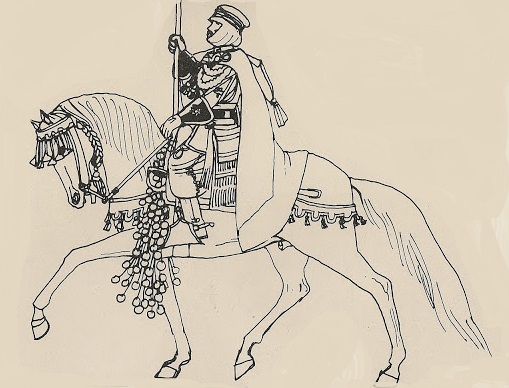
Bureau es una palabra francesa que se utiliza para referirse a un tipo de escritorio con muchos cajones y tapa corredera que cubre la mesa y se puede cerrar con llave.
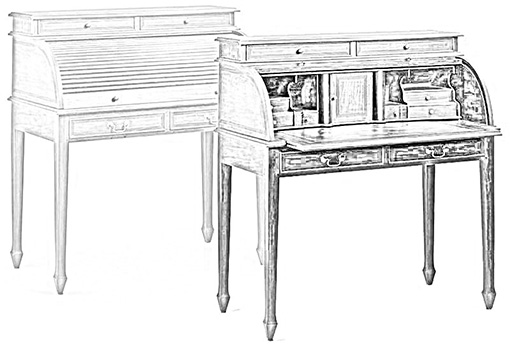
Este relato es una adaptación de un cuento de la autora inglesa Edith Nesbit titulado “The Town in the Library, in the Town in the Library” de la colección de cuentos Nine Unlikely Tales for Children, ilustrada por H. R. Millar y publicada en Londres en 1901.
Este cuento no tenía en el original ninguna ilustración. La editorial Calleja ya había publicado una versión de este cuento como “La ciudad en la biblioteca”, un título más parecido al original, en la colección de cuentos de Nesbit, El dragón de Llama, con tres de las ilustraciones de Federico Ribas que aparecen en este cuento.

What time of the year do you think it is? Find two pieces of evidence in this first paragraph that support your guess.
La torta con el haba es el roscón de Reyes. Antiguamente, en Francia se celebraba el día de Reyes con un pastel en el que se había escondido un haba. Quien la encontraba recibía el título de "Rey del haba" y se le colmaba de atenciones ese día. Esa tradición pasó a España y se sigue celebrando, utilizando una figurita en lugar del haba.
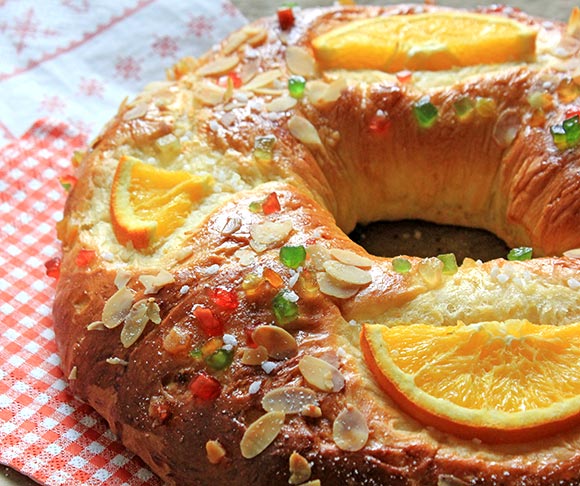
Si te apetece, cuando acabes el cuento, pídele a algún mayor que te ayude con esta deliciosa receta.
A contagious illness that causes red spots on the skin and high temperature. Children have it more frequently than adults unless they are vaccinated.
Example: Tommy didn’t go to school when he had measles.

The seed of certain plants which are eaten as a vegetable in stews, soups, salads, or as a side dish.
Example: The smell of the bean stew was delicious.

A person who works taking care of children.
Example: The nanny told the children a story at bedtime.

The three kings who bring gifts to baby Jesus.
The names of the Three Wise Men were: Balthazar, Gaspar, and Melchior.
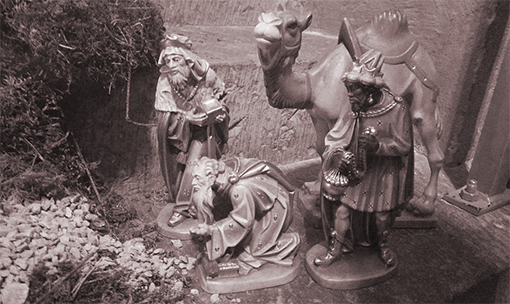
A chest or piece of furniture for writing with drawers (boxes that slide in and out and are used to hold things). It can have a top that locks with a key and opens upwards.
Example: The old wooden bureau contained old secret documents.

To prohibit.
Example: Smoking is forbidden in schools and hospitals.
What time of the year do you think it is? Find two pieces of evidence in this first paragraph that support your guess.
Why do you think that Rosie and Fabian’s mother doesn’t let them open the two drawers? Try and guess the reason!
We are sure that you know what a bureau is and what it is for. Can you name up to five things that you would typically find in the drawers of a bureau and five things that you would never ever find there?
Druids were a high-ranking professional class in ancient Celtic cultures, and undertook many roles in society, including religious leaders, legal authorities, political advisors, and medical professionals.
Can you imagine the domestic life of ancient druids? List up to three things that they would do in a normal day that would be different from today. For example:
1st: Ancient druids would wake up at dawn so that they could pick magic herbs and flowers at that special time of day to use in their potions later on in the day.
2nd: ...

Think of an illness and compare how modern doctors would treat it with how ancient druids would. Then share it with your group and debate together about whether one of the treatments might be more effective than the other.

Do you think that the image below corresponds roughly to one of the toys found in the bureau? Which one? Draw the shop window of a toy shop. How would you display the toys found in the bureau so that passers-by would be attracted by them and buy them?
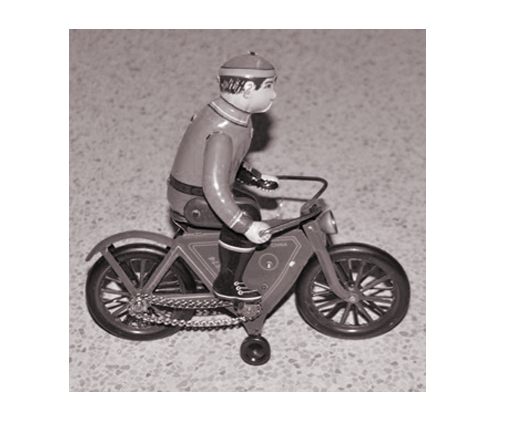
Think of the toys mentioned on the page, which probably correspond to the type of toys that your grandparents had. Ask the elder members of your family whether they remember any of the following toys. Can you see any difference between them and the ones that you typically receive on your birthday or at Christmas?
Bureau es una palabra francesa que se utiliza para referirse a un tipo de escritorio con muchos cajones y tapa corredera que cubre la mesa y se puede cerrar con llave.

Aunque a los niños del cuento "La vida doméstica de los antiguos druidas" no les llama la atención, seguro que era un libro muy interesante. Imagina qué contenido podría tener ese libro y escribe alguna de sus páginas.

¿Cómo eran los juguetes de tus padres y abuelos? Pregúntales si tuvieron algunos de estos.
Individual publication in a series of magazines, newspapers, comic books, etc.
Example: The man sold all his old issues of comics from when he was a child.

Have you ever noticed that you use different intonation patterns (your voice goes up and down) when you speak according to what you say and your intention while saying it? Please undertake the following five steps:
Rosie and Fabian use a six-sided puzzle to make a castle. Each side contains a beautiful picture. Go to the webpage of a famous museum and select six paintings that you like, each one corresponding to the following famous painters:
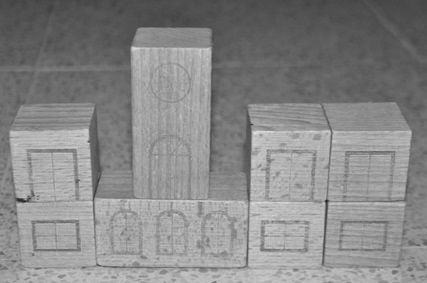
A weapon that consists of a knife attached to the front end of a rifle.
Example: Bayonets were used in close fighting long ago.
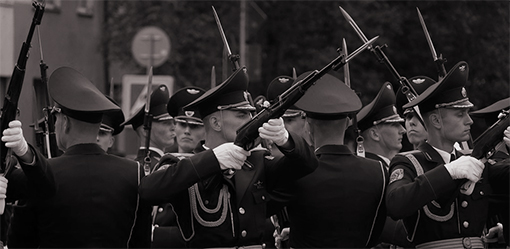
Be painful.
Example: His knee hurt after falling.
A heavy sword with one sharp curved edge.
Example: My grandfather has a sabre on the wall from the Mexican war.
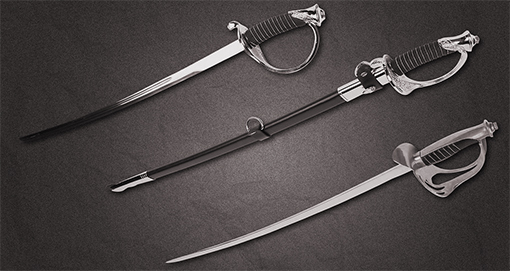
To start crying.
Example: He burst into tears when his new toy broke.

Probablemente, una de las imágenes del puzle era el famoso cuadro de Murillo "Rebeca y Eliezer", que describe una escena de la Biblia. Abraham le pide a su criado Eliezer que vaya en busca de una esposa para su hijo Isaac. Eliezer encuentra a la bondadosa Rebeca, que le da agua de su cántaro y decide que ella es la escogida.
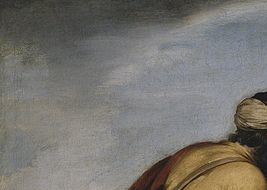
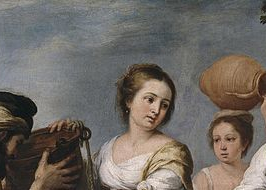
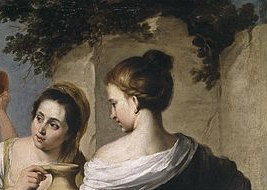
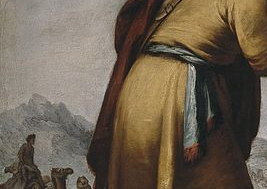
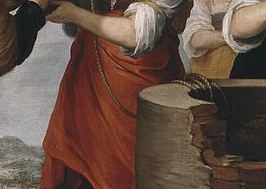

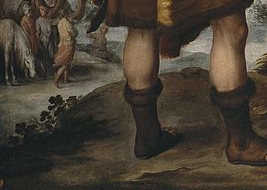
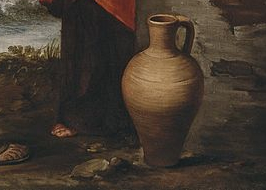
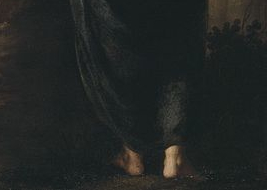
Daoíz y Velarde: Se refiere a los nombres de los capitanes Luis Daoíz y Torres y Pedro Velarde, oficiales de artillería del cuartel de Monteleón que se sumaron al levantamiento del 2 de mayo de 1808 contra las tropas francesas.
Hay muchas imágenes y monumentos en Madrid que los retratan como héroes, ¡encuéntralos!
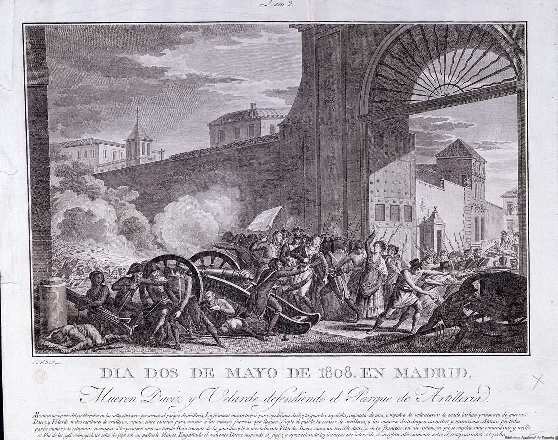
Aquí puedes leer más información
A pointed metal bar used to move around the coals or the wood in the fire.
Example: Our father used the fire poker to adjust the wood in the fireplace.

A device with long sides for picking up objects without touching them.
Example: Grandpa picked up the burning log with the tongs.

Aquí se están refiriendo a libros muy gordos y de varios volúmenes que solían estar en las bibliotecas de familias que podían permitírselo:
El César Cantú: Un historiador italiano especialmente conocido por los treinta y cinco volúmenes de su Historia Universal, publicada a mediados del siglo XIX.
El Lafuente: Modesto Lafuente es recordado por su monumental Historia General de España, en seis tomos y treinta volúmenes, publicada en la segunda mitad del siglo XIX.
El Alcubilla: Marcelo Martínez Alcubilla fue un experto en leyes y en la historia del derecho español que escribió varias colecciones de textos sobre leyes que mucha gente consultaba en la época, pues estaban muy bien resumidos. Uno de sus libros más famosos es el Diccionario de la administración española (1858-1862), que fue ampliado una y otra vez hasta llegar a cinco reediciones durante el siglo XIX y continuado por sus hijos.

A plank; a flat, cut piece of wood.
Example: The child fixed small wheels to the board and then jumped on it.

Alquicel: Es una palabra que viene del árabe y se refiere a un tipo de vestidura a modo de capa, que normalmente era blanca y de lana.
Si quieres conocer qué otras palabras son de origen árabe, utiliza el diccionario e investiga: ¿Son de origen árabe estas palabras: “alcohol”, “almohada”, “aleta”, “alcázar”, “alcaldía”, “alhelí” y “altura”?

A grey metal which is very heavy.
Example: That shield is made of lead to protect the doctor against radiation.

The gathering of ripe crops or plants grown on a farm.
Example: The harvest of wheat is typically in the summer.

A story from the Bible which narrates how a woman called Rebecca was chosen to be Isaac’s wife by his father’s servant because she was by a particular well and said and did what he was expecting, which he interpreted to be a sign of God.

Two Spanish captains who raised against French Napoleonic occupation and rule, and fought in a famous and decisive battle which took place in Madrid on May 2nd 1808.

Using the memory.
Example: The child learnt the song by heart for the festival.
A famous Spanish legal dictionary written by lawyer Marcelo Martínez Alcubilla in the 19th century.
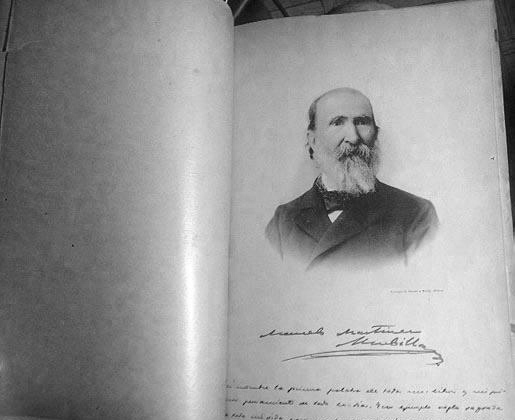
A long narrative poem by 14th century Italian author Dante Alighieri. It is considered to be one of the greatest works of world literature.

There is a famous rhyme that English children say:
“I’m the king of the castle and you’re the dirty rascal!”
This is equivalent in Spanish to poking your tongue out and saying: "Na-na-na-naaa-na”
Let’s investigate it:
Did you know that this is one of the most important books in the Spanish literary tradition? It was written by Miguel de Cervantes in the 17th century.
Here you can view an image and you can also read it http://quijote.bne.es/libro.html.
Think of four famous children’s tales that you would like to use as the northern, western, eastern and southern doors of a medieval city made of books (as in the story). There are two conditions:
Give a smart reason for your choice.
Imagine you are in the same situation, threatened by the Moors. What would be the best way to solve such a threatening situation?
Write down your answer, explaining why you think your solution is the best one. Once you have written your answer, discuss with your partners which solution would be more effective.
Do you think that you could write a short rhyming poem about medieval times with a good rhythm? Something like…
Henry VIII to six wives was wedded:
One died, one survived, two divorced, two beheaded!
or
One eyed Jack the Pirate Chief
Was a terrible, fearsome ocean thief.
He wore a peg upon one leg,
He wore a hook and a dirty look!
Have you noticed that all lines start with a capital letter? It has to be that way in English.

Los escritores utilizan muchos trucos para hacer sus historias interesantes. En este caso, la autora hace que los juguetes y los espacios de juego que construyen los niños cobren vida y se hagan reales dentro de la historia. ¿Conoces otros cuentos en los que ocurra hacen algo parecido?
Aquí tienes un ejemplo muy famoso:

To use up the entire amount of something.
Example: It was such a hot day that we ran out of drinks.

The official residence of the Spanish Royal Family.
Example: Madrid's Royal Palace is only used for state ceremonies.

A long, usually hard seat for two or more people, often found in public places.
Example: There are many benches at the park.

Extremely surprised.
Example: I was amazed to hear who had won the first prize.
A fortification built for protection around a town.
Example: There are many city walls in Spain (Segovia, Avila, Toledo).

Manuel Rivadeneyra (1805-1872) fue un editor e impresor español que desde 1846 trató de reunir las obras clásicas de la literatura española en una colección que se llamó la Biblioteca de Autores Españoles.

Otro truco para hacer una buena historia es jugar con los narradores y el origen del cuento. Nuestro narrador ha escuchado la historia que acabamos de leer de uno de los personajes del cuento. ¿No es un poco raro? ¿Te fiarías tú de lo que cuente un ratón mecánico?

Inventa una historia con un narrador poco fiable ¡pero divertido!
Let’s try and figure out who the soldiers that came alive in the story are fighting against: they are Moors and probably in the Middle Ages (they wear cloaks, have sabres and bayonets and are in a medieval city). Hint: They are fighting in the Iberian Peninsula.
The answer is a bit further down on the same page. Do you remember from your History lessons what they could be fighting about?
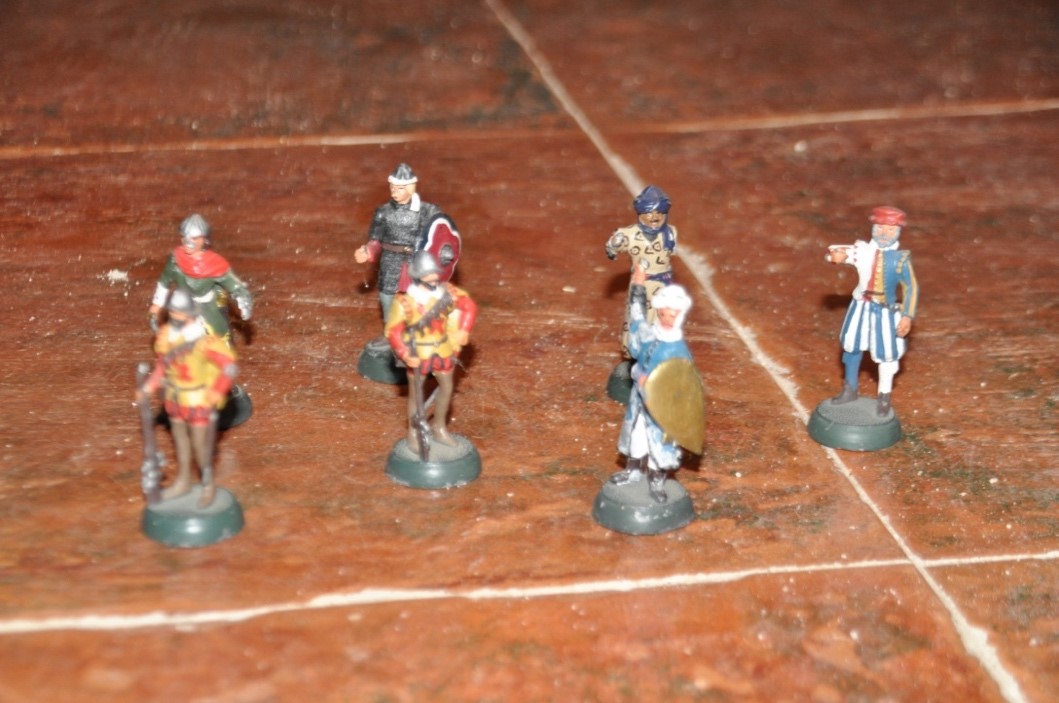
This is a most peculiar way of providing supplies to soldiers, don’t you think? Why do you reckon that Rosie and Fabian are feeding the soldiers? ;-)
Imagine you are in the same situation, threatened by the Moors. What would be the best way to solve such a threatening situation?
Write down your answer, explaining why you think your solution is the best one. Once you have written your answer, discuss with your group which solution would be the most effective one.
Between the 8th and the 15th century, Christians fought the Moors to recover the Iberian Peninsula. This process is called the Reconquest.
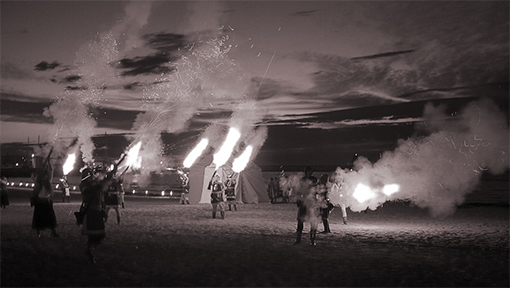
All throughout this story there are two scenarios: a real one in Rosie and Fabian’s library and an imaginary one in a medieval city which is about to become a battlefield… which is inside the library! Where are the children right now: still in the battlefield or back in the library?
A long coat.
Example: The wizard had a purple cloak with stars on it.

To win against someone in a fight, war, or competition.
Example: The Duke of Wellington defeated Napoleon at the battle of Waterloo.
When soldiers are organized into a particular shape.
Example: Soldiers marched in military formation.

A matter or a problem.
Example: Climate change is an issue for planet Earth.
North African Muslims.
Example: In the Middle Ages the Moors introduced many new scientific techniques to Spain and the rest of Europe.

To quickly leave a place.
Example: He ran away from the ship when the pirates were sleeping.
A plank with wheels underneath. It can be a skateboard, which is a flat, short, narrow board that has four wheels on the bottom and is used for practising a sport.
Example: It is more fun to stand on your skateboard than to sit on it.
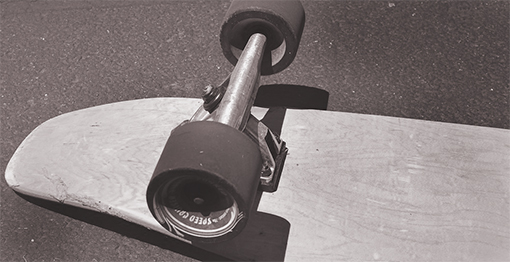
Very hungry.
Example: The lion has a voracious appetite!
An expression used when the reason for something is obvious.
Example: Look at those bird footprints. There is no room for doubt about who ate the cake.
A plank with wheels underneath. It can be a skateboard, which is a flat, short, narrow board that has four wheels on the bottom and is used for practising a sport.
Example: It is more fun to stand on your skateboard than to sit on it.

A famous Spanish editor who lived in the 19th century, who published many Spanish works and collections with high quality.

Listen to what Fabian’s mother says when she opens the library door:
“You have taken all the toys and you have eaten all the sweets!”
What mood is she in? Now think of something that adults tell you off about from time to time and try to use the same intonation.
If a friend of the children had opened the door instead of their mother, they might have said the same thing naughtily in admiration:
“You have taken all the toys and you have eaten all the sweets!”
How would s/he say it? Try to say it out loud with an adequate intonation.
If a little brother or sister had opened the door, they might have said the same thing with fear for a reprimand. Try to say it out loud with the corresponding intonation too.
You have been listening to the narrator tell the story. Here she mentions herself for the first time. Listen to her voice attentively. Who do you think she is? Use your imagination to provide information about her: her name, nationality, age, what she is like, her profession, and how she came to know about the story. Try to link your guesses to her voice.
This is the end of the story. Rosie and Fabian are sick in bed. In their feverish sleep, they have a nightmare about being judged in court for having been disobedient and reckless. Distribute the roles at court among the members of your group:
Try to follow the main norms in a real court situation (respect to the magistrates’ indications, turn taking, etc.) and come out with a sentence.
Don’t forget to finish the role play by waking Rosie and Fabian up at the end!
